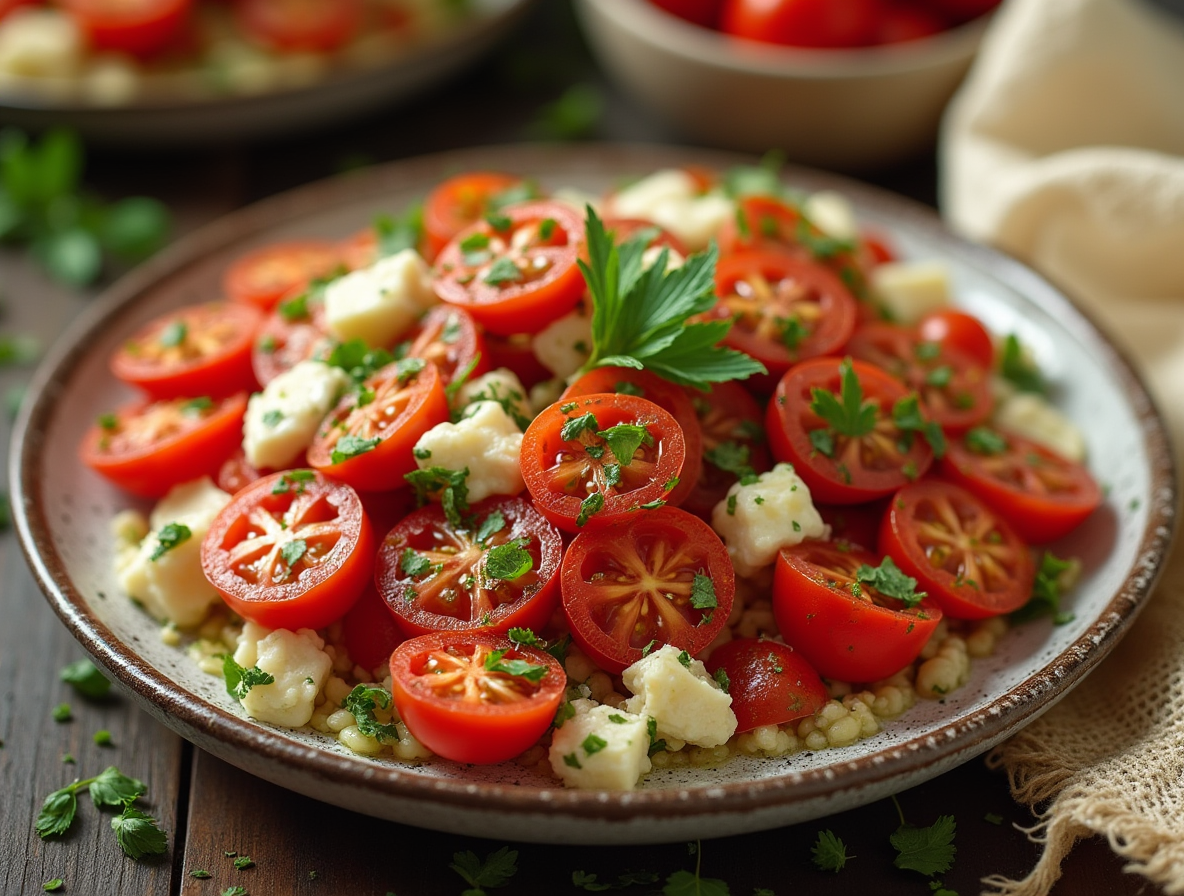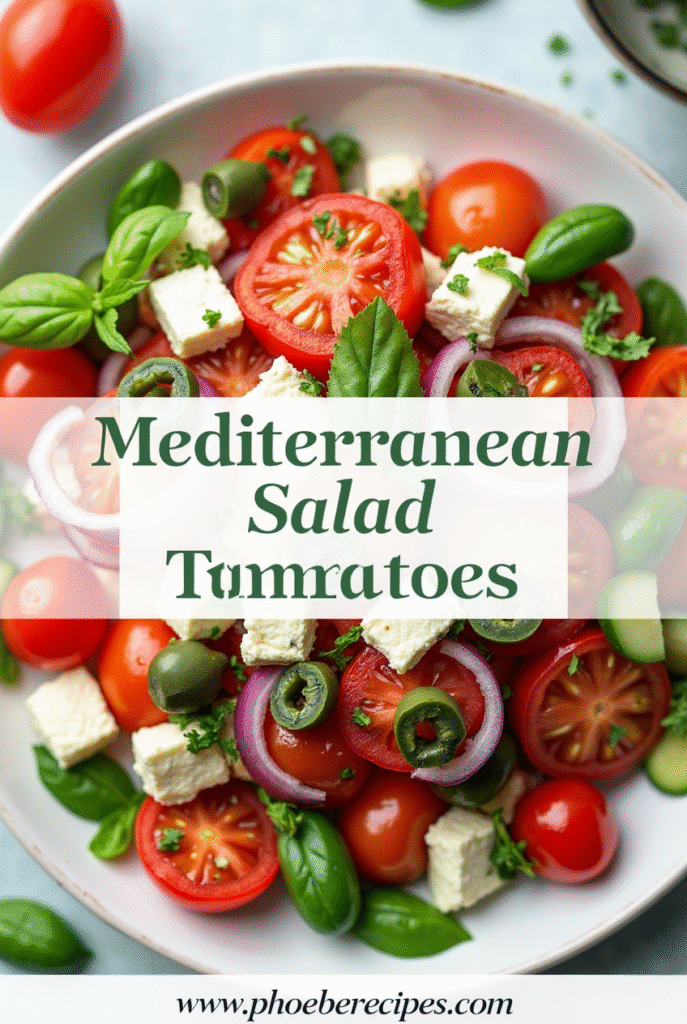The Perfect Mediterranean Salad Recipe: A Chef’s Secret Method Revealed
Mediterranean salad recipe enthusiasts know that the perfect combination of fresh ingredients can transform a simple dish into something extraordinary. I’ve spent years perfecting my approach to this classic, and today I’m excited to share my chef-inspired method that takes just 10-15 minutes to prepare while delivering authentic Mediterranean flavors.
Traditional Mediterranean salad ingredients like crisp Romaine lettuce, juicy cherry tomatoes, cucumbers, Kalamata olives, and creamy feta cheese form the foundation of this nutritious meal. Actually, a typical serving contains approximately 131 calories, with a balanced 9 grams of fat, 9 grams of carbohydrates, and 6 grams of protein. What makes this easy Mediterranean salad recipe particularly appealing is its versatility – it can feed 6-8 people, making it perfect for gatherings, or you can prepare it for your weekly meal prep. Additionally, you can customize it with protein sources like chickpeas, which add 385 calories, 70 grams of carbs, and 18 grams of protein, transforming it into a satisfying main course.
In this guide, I’ll walk you through my step-by-step process for creating the perfect Mediterranean salad, from selecting the freshest ingredients to crafting a balanced dressing that brings everything together. Whether you’re a seasoned cook or just starting your culinary journey, these chef-approved techniques will elevate your Mediterranean cuisine game.
The essential Mediterranean salad ingredients
Creating an authentic Mediterranean salad starts with selecting the right ingredients. My experience has taught me that the quality of each component makes a significant difference in the final flavor profile.
Fresh vegetables that form the base
The foundation of any traditional Mediterranean salad begins with ripe, juicy tomatoes and crisp cucumbers. Roma or cherry tomatoes work exceptionally well because they stay somewhat firm when ripe and release less water into the salad. For cucumbers, I recommend English or Persian varieties as they have thinner, more delicate skins and tend to be sweeter. Moreover, seeding your cucumber prevents the salad from becoming watery.
Green bell peppers add a refreshing crunch and are the only bell pepper used in authentic Mediterranean salads. Some regions incorporate different vegetables according to local traditions – for instance, in Paros they add lettuce, while many American versions include romaine as a base.
Choosing the right feta cheese
Not all feta is created equal. For the most authentic experience, look for Greek sheep’s milk feta, which offers the creamiest texture and richest flavor. Instead of using pre-crumbled feta, choose blocks packed in brine – they boast better flavor and allow you to serve large chunks that can act as the centerpiece of your salad. In some Greek islands like Naxos, locals substitute feta with their regional cheese called xynomyzithra.
Why olives and onions matter
Kalamata olives provide the essential briny, salty flavor that defines Mediterranean salads. These dark, intensely fruity olives are vastly superior to standard black olives. Red onions contribute a zippy sweetness and sharp contrast. However, if you find raw onions too potent, soak sliced onions in ice water with a teaspoon of red wine vinegar for about 10 minutes to mellow their bite.
Optional add-ins for extra flavor
While the classic recipe remains simple, these additions can enhance your Mediterranean salad:
- Chickpeas or white beans for protein and heartiness
- Fresh herbs like parsley (common in Northern Greece), mint, or dill
- Sun-dried tomatoes for concentrated umami flavor
- Roasted red peppers for smoky sweetness
- Capers (typically used in the Cyclades)
Furthermore, some creative regional variations exist – in Mykonos, watermelon sometimes replaces tomatoes during summer, and in Crete, barley rusk creates a unique texture.
How to make the perfect Mediterranean salad dressing
The secret behind every magnificent Mediterranean salad recipe lies in its dressing. As a chef who has spent years perfecting this culinary art, I can tell you that the right dressing elevates simple vegetables into something extraordinary.
Classic vinaigrette vs creamy dressing
Traditional Mediterranean vinaigrettes typically combine red wine vinegar, olive oil, and dried herbs for a light, tangy finish. In contrast, creamy Mediterranean dressings incorporate ingredients like Greek yogurt or crumbled feta cheese for a richer texture. To create a creamy Greek dressing, blend ⅓ cup olive oil with 2 tablespoons red wine vinegar, 1 tablespoon Dijon mustard, ⅓ cup crumbled feta, and ¼ cup Greek yogurt. This versatile option works wonderfully on traditional salads, pasta salads, and even as a sandwich spread.
Balancing acidity and oil
The cornerstone of a perfect Mediterranean salad dressing recipe is achieving the ideal oil-to-acid ratio. Most chefs recommend a 3:1 ratio (three parts oil to one part acid) for a balanced dressing. Nevertheless, some traditional recipes prefer a higher vinegar content for more tanginess. When selecting olive oil, quality matters tremendously – use an extra virgin olive oil with a flavor profile you enjoy. Additionally, sweeteners like honey or a pinch of sugar can help tame excessive acidity without overwhelming the dressing.
Using herbs like oregano and dill
Oregano and thyme serve as the signature herbs in traditional Mediterranean dressings, providing that authentic flavor profile. Fresh herbs add vibrant flavor, but dried herbs offer more concentrated taste – generally, double the amount when substituting fresh herbs for dried. For variety, consider incorporating basil, parsley, or mint to create regional variations that complement specific ingredients in your salad.
Tips for emulsifying your dressing
Emulsification prevents the frustrating separation of oil and vinegar, creating a uniform dressing that clings beautifully to salad ingredients. Dijon mustard works as an excellent emulsifier, but alternatives include honey, mayonnaise, or even mashed avocado. For proper emulsification, firstly combine all ingredients except oil in a bowl, subsequently slowly drizzle in the oil while whisking vigorously. Alternatively, place all ingredients in a mason jar and shake energetically until the mixture appears cloudy and slightly thickened. Properly emulsified dressings can stay mixed for days when refrigerated.
Step-by-step guide to assembling the salad
The assembly process elevates a simple Mediterranean salad from good to exceptional. Following chef-approved techniques ensures every bite delivers balanced flavors and textures in your traditional Mediterranean salad.
Chop ingredients uniformly
Consistency in sizing creates a harmonious eating experience. Aim for 1-inch pieces for most ingredients, though you may want finer cuts for intense flavors like red onion. This uniform approach ensures each forkful contains a perfect blend of all ingredients. For cucumber preparation, slice into thin half-moons after peeling, halving lengthwise, and removing seeds. Most chefs recommend keeping pitted Kalamata olives whole rather than chopping them. Besides esthetics, uniform cutting helps ingredients marry together properly when dressed.
Layering vs tossing: what chefs prefer
Professional chefs are divided on this technique. Some prefer layering ingredients for impressive presentation—arranging components on a large platter or building distinct sections. Others advocate thoroughly tossing everything together, ensuring each piece gets coated with dressing. For stunning visual impact, try the “trifle dish method”—creating visible layers around the perimeter of a clear bowl while filling the center with lettuce. Consequently, each serving showcases the vibrant colors of your Mediterranean salad recipe.
When to add the dressing
Timing is critical for the perfect texture. Many chefs recommend a two-stage approach: first, marinate harder vegetables like cucumbers and onions in the dressing for 5-30 minutes, then add remaining ingredients. For everyday serving, toss everything together with dressing just before bringing to the table. Certainly, if you’re expecting leftovers, serve dressing separately—this prevents wilting and sogginess during storage.
Garnishing for presentation
The final touches make your best Mediterranean salad recipe shine. Serve on white plates where colors pop against the neutral background. Garnish with extra herbs like parsley, a drizzle of olive oil, or a sprinkle of black pepper. For Mediterranean authenticity, tear (don’t cut) mozzarella into chunks and arrange on top. Small details like uniformly square diced items create visual appeal that elevates the entire dish.
Customizations and chef-approved variations
A basic Mediterranean salad offers a delicious foundation for countless variations. With a few strategic additions, you can transform this classic dish into a meal that meets specific dietary needs or flavor preferences.
Add protein: chicken, shrimp, or chickpeas
The addition of protein turns a simple Mediterranean salad into a satisfying main course. Chickpeas are perhaps the most traditional option, loaded with protein and making any salad more filling. For extra protein, consider adding flaked canned tuna or shredded rotisserie chicken. Grilled chicken or steak pairs excellently with the fresh vegetables and tangy dressing. Alternatively, shrimp provides a lighter protein source that complements the bright Mediterranean flavors. Above all, this protein-packed approach creates a complete meal that keeps you satisfied for hours.
Make it a grain bowl with quinoa or farro
Creating a Mediterranean grain bowl elevates your salad to new heights. Farro, a hearty ancient Mediterranean grain, offers great texture and a slight nutty flavor. Similarly, quinoa is highly nutritious and provides a complete protein (containing all essential amino acids). Alternatively, try brown rice for a gluten-free option that maintains the hearty texture. In fact, these grain-based salads make perfect meal prep options—prepare them ahead and enjoy throughout the week. To enhance flavor, consider additions like pine nuts or quick-pickled red onions.
Vegan and dairy-free swaps
Creating a dairy-free Mediterranean salad is straightforward with a few simple substitutions. To make it dairy-free, simply omit the feta cheese. Undeniably, vegan versions can be equally delicious—some recipes use dairy-free feta alternatives that provide the ideal creaminess and saltiness. For added richness without dairy, try adding avocado. Chickpea salads specifically shine in plant-based diets, offering protein, contrasting textures, and fresh herbs. To maintain flavor depth without cheese, consider increasing herbs, capers, or olives.
Turning it into a pasta salad
Mediterranean pasta salad transforms the traditional recipe into a hearty dish perfect for potlucks and picnics. Farfalle (bow-tie) pasta works wonderfully, though any pasta type can succeed. The addition of chickpeas provides extra protein, making it easy to turn into a main dish. For extra freshness, try adding fresh herbs like mint, basil, or parsley. A lemon-herb vinaigrette featuring red wine vinegar, olive oil, oregano, and garlic perfectly complements the pasta and vegetables. Unlike other variations, pasta salad actually improves with time as flavors meld together, making it ideal for meal prep.
Conclusion
Mediterranean salads stand as one of the most versatile dishes you can add to your culinary repertoire. Throughout this guide, I’ve shared my chef-tested approach to creating an authentic Mediterranean salad that balances fresh ingredients with perfect proportions.
Quality ingredients undoubtedly make all the difference. Fresh vegetables like tomatoes, cucumbers, and bell peppers provide the foundation, while authentic Greek feta cheese and Kalamata olives deliver that distinctive Mediterranean flavor profile. The dressing, accordingly, deserves special attention—balancing oil and acid in the right proportions while incorporating herbs like oregano creates that signature taste we associate with Mediterranean cuisine.
Assembly techniques also play a crucial role. Uniform cutting ensures each bite delivers balanced flavors, while proper timing when adding dressing maintains ideal textures. Additionally, your personal preferences should guide whether you layer ingredients for presentation or toss everything together for even distribution.
Perhaps the most beautiful aspect of Mediterranean salads lies in their adaptability. You can transform this basic recipe into countless variations—adding protein for a complete meal, incorporating grains for heartiness, making dairy-free substitutions, or even creating a pasta version for gatherings. Each adaptation maintains the core Mediterranean principles while allowing customization to your dietary needs and taste preferences.
Finally, remember that Mediterranean salads represent more than just delicious food. This traditional dish embodies a lifestyle centered around fresh ingredients, simple preparation, and nutritional balance. Whether you prepare it as a light lunch, side dish, or main course, these chef-approved techniques will elevate your Mediterranean salad from ordinary to extraordinary. Try this method once, and I’m confident it will become a staple in your kitchen!
FAQs
Q1. What are the key ingredients in a Mediterranean salad? A Mediterranean salad typically includes fresh vegetables like tomatoes, cucumbers, and bell peppers, along with Kalamata olives, feta cheese, and red onions. The dressing usually consists of olive oil, red wine vinegar, and herbs like oregano. Optional add-ins can include chickpeas, fresh herbs, or roasted red peppers for extra flavor and nutrition.
Q2. How do you make the perfect Mediterranean salad dressing? The perfect Mediterranean salad dressing balances oil and acidity in a 3:1 ratio. Use quality extra virgin olive oil and red wine vinegar as the base. Add dried herbs like oregano and thyme for authentic flavor. To emulsify the dressing, whisk in a bit of Dijon mustard or honey. For a creamier version, incorporate Greek yogurt or crumbled feta.
Q3. What’s the best way to assemble a Mediterranean salad? For the best Mediterranean salad, chop ingredients uniformly (about 1-inch pieces) for a balanced bite. Some chefs prefer layering ingredients for presentation, while others advocate tossing everything together. Add the dressing just before serving to maintain freshness. Garnish with extra herbs, a drizzle of olive oil, or a sprinkle of black pepper for the finishing touch.
Q4. How can I turn a Mediterranean salad into a complete meal? To transform a Mediterranean salad into a complete meal, add protein such as grilled chicken, shrimp, or chickpeas. You can also make it heartier by incorporating grains like quinoa or farro, turning it into a Mediterranean grain bowl. These additions increase the salad’s nutritional value and make it more filling.
Q5. Are there any vegan options for a Mediterranean salad? Yes, Mediterranean salads can easily be made vegan. Simply omit the feta cheese or use a dairy-free feta alternative. Increase the amount of olives, capers, or herbs to maintain flavor depth. Add avocado for creaminess and chickpeas for protein. You can also incorporate more vegetables or nuts to create a satisfying and nutritious vegan Mediterranean salad.


